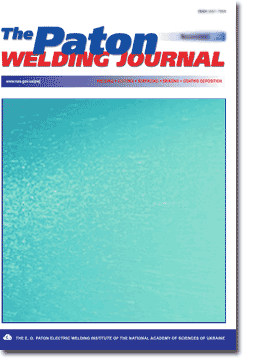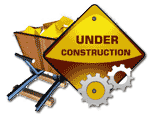

| SCIENTIFIC AND TECHNICAL | |
| Surfacing at the E.O. Paton Electric Welding Institute | 2 |
| Ryabtsev I.A., Kuskov Yu.M., Ryabtsev I.I.,Novikova D.P., Grigorenko S.G. and Kostin V.A. Secondary hardening of deposited metal of the type of dispersion-hardening steel of Fe-C-Ni-Cr-Si-Al-Cu alloying system | 4 |
| Metallographic studies of deposited metal of dispersion-hardening steel of Fe-C-Ni-Cr-Si-Al-Cu system have been conducted. It is shown that secondary hardening of deposited metal proceeds in two stages, depending on tempering duration. In the first stage it proceeds through residual austenite decomposition and martensite formation. In the second stage with longer duration of tempering, martensite decomposes with formation of new phases, namely high-alloyed ferrite and dispersed inclusions with a higher content of silicon and nickel. | |
| Kuzmenko O.G. Behavior of particles of a non-compact filler at air-slag interface in electroslag hardfacing | 8 |
| Data are given on behavior of particles of non-compact materials (chips and shot) on the surface of the pool in electroslag surfacing. Conditions have been determined for fixation of these particles at the air-slag interface. It is shown that shot of chromium cast iron with a diameter of up to 2.3 mm and chips of tool steel 5KhNM up to 2.7 mm thick (fixation by the largest side) or up to 0.6 mm thick (fixation by the smallest side) may float on the surface of the slag pool. | |
| Kondratiev I.A., Ryabtsev I.A. and Chernyak Ya.P. Study of properties of deposited metal of the maraging steel type | 12 |
| Structure and properties of maraging steels deposited with flux-cored wires of different alloying systems have been studied. Optimal composition of deposited metal has been determined. In the as-deposited condition this metal has hardness HRC30, which makes it easy to cut, whereas after tempering at 480 °C for 3 h its hardness grows to HRC50. The deposited metal after tempering has good high-temperature strength, which allows it to be recommended for hardening of working surfaces of complex-configuration die tools. | |
| Pulka Ch.V., Shably O.N. and Pismenny A.S. Effect of induction surfacing conditions on structure and properties of deposited metal | 15 |
| The paper gives results of investigation of structure and properties of metal deposited by the induction surfacing method that involves screening of thermal and electromagnetic fields. It is shown that owing to screening the non-uniformity of thickness of the deposited metal layer is decreased by 12%, saving of power amounts to 10-15%, overheating of the edge of disc and deposited metal is eliminated, and the time of surfacing is reduced as compared with surfacing without screening. In this case the microstructure, hardness and wear resistance of the deposited metal remain at the same level as in induction surfacing without screening. | |
| Osin V.V. and Ryabtsev I.A. Effect of sulphur on properties of iron-base alloys and prospects of its application in surfacing materials | 18 |
| Literature data about the effect of sulphur on mechanical and service properties of steels and cast irons have been analyzed. It is shown that sulphur is a promising alloying element in surfacing consumables designed for repair and hardening of parts that operate under the conditions of friction of metal on metal at increased temperatures and are subjected to adhesion wear. | |
| Sokolov G.N., Zorin I.V., Tsurikhin S.N. and Lysak V.I. Features of the process of ESH with a composite rod in a small-sized sectioned mould | 22 |
| Electrophysical and thermal peculiarities of electroslag hardfacing (ESH), using an additional hollow graphite electrode, are considered. It is shown that addition of a nonconsumable electrode to the slag pool leads to formation of a high-temperature region in it, which allows a uniform melting of different components of hardfacing consumables. Use of ESH enables producing a heat-resistant deposited alloy based on nickel aluminide. | |
| Demchenko V.F. and Kozlitina S.S. Computer systems of information support of welding fabrication | 26 |
| Described are the information support systems, developed by the E.O. Paton Electric Welding Institute for welding and surfacing technologies. | |
| INDUSTRIAL | |
| Pereplyotchikov E.F. Plasma-powder cladding of wear- and corrosion-resistant alloys in valve manufacturing | 31 |
| Results of investigation of alloys used in valve manufacturing for cladding of stop valve components are given. Peculiarities of plasma-powder cladding are considered. It is shown that plasma-powder cladding provides the best performance of seal surfaces. | |
| Wu J.B.C. and Pavlenko A. Cobalt-based alloys for surfacing against wear and corrosion | 38 |
| Cobalt-based alloys for resisting wear and corrosion were first developed prior to 1907 under the trademark Stellite(r). Additional alloys were later developed for needs in a variety of applications. Cobalt alloys can be applied on the surface of industrial components by hardfacing or thermal spraying. This paper is intended to review the traditional, as well as recently developed cobalt alloys in regards to their metallurgical characteristics and industrial applications. Various technologies for surfacing are discussed. Examples of using cobalt alloys in various industries for surfacing are illustrated in this work. | |
| Som A.I. Plasma-powder surfacing of composite alloys based on cast tungsten carbides | 43 |
| Wear resistance of deposited metal, depending on the quantity and shape of the reinforcing tungsten carbide particles, methods for their addition to the weld pool and type of matrix has been investigated. It is shown that the best combination of service and technological properties of the deposited metal is achieved at its carbide content of about 50 vol.%. | |
| Gulakov S.V., Chigarev V.V., Ivanov V.P., Psareva I.S. and Lavrentik O.A. Improvement of technology for hardfacing of metallurgical equipment components | 48 |
| The ways of improving the quality of deposited metal through forming the working surface by layers of variable chemical composition and complex shape are considered. The latter increase the technological capabilities of the process, widen the sphere of application of deposited components and impart them a new combination of service properties. | |
| Kuskov Yu.M., Kuzmenko O.G. and Lentyugov I.P. Electroslag processing of metal wastes and using of resulting semi-finished products for cladding applications | 52 |
| Technologies developed by the E.O. Paton Electric Welding Institute for processing of different-production metal wastes by the electroslag process are considered. This approach holds promise in terms of involving secondary resources into production, as shown by examples of remelting and cladding using tool steel chips, slime wastes, ash residues and copper chops, and proved by positive results obtained from utilisation of the remelted metal in the form of finished or semi-finished products. | |
| Sokolov G.N. Properties of deposited metal used for metallurgical tool hardening | 55 |
| Problems associated with rational alloying of deposited metal of the Ni-Cr-Mo-Nb-C system to provide hardening of metallurgical tool operating at temperatures up to 900 °C are considered. The effect of molybdenum and niobium content on high-temperature hardness, susceptibility to hot cracking and heat resistance of deposited metal has been studied. | |
| Zhudra A.P., Voronchuk A.P., Veliky S.I. and Fomakin A.A. New equipment for hard-facing of blast furnace bells and hoppers | 58 |
| Design peculiarities and technical capabilities of the device developed for wide-layer hard-facing of metallurgical equipment are briefly described. | |
(You are viewing the simplified file contents)
Sorry, the PDF of this issue is not yet available
The cost of subscription/purchase order journals or individual articles
| Journal/Currency | Annual Set | 1 issue printed |
1 issue |
one article |
| TPWJ/USD | 384 $ | 32 $ | 26 $ | 13 $ |
| TPWJ/EUR | 348 € | 29 € | 24 € | 12 € |
| TPWJ/UAH | 7200 UAH | 600 UAH | 600 UAH | 280 UAH |
| AS/UAH | 1800 UAH | 300 UAH | 300 UAH | 150 UAH |
| AS/USD | 192 $ | 32 $ | 26 $ | 13 $ |
| AS/EUR | 180 € | 30 € | 25 € | 12 € |
| SEM/UAH | 1200 UAH | 300 UAH | 300 UAH | 150 UAH |
| SEM/USD | 128 $ | 32 $ | 26 $ | 13 $ |
| SEM/EUR | 120 € | 30 € | 25 € | 12 € |
| TDNK/UAH | 1200 UAH | 300 UAH | 300 UAH | 150 UAH |
| TDNK/USD | 128 $ | 32 $ | 26 $ | 13 $ |
| TDNK/EUR | 120 € | 30 € | 25 € | 15 € |
AS = «Automatic Welding» - 6 issues per year;
TPWJ = «PATON WELDING JOURNAL» - 12 issues per year;
SEM = «Electrometallurgy Today» - 4 issues per year;
TDNK = «Technical Diagnostics and Non-Destructive Testing» - 4 issues per year.


